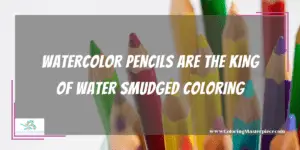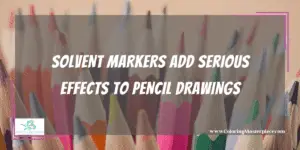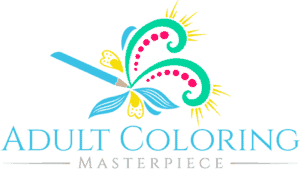A regular colored pencil sometimes leaves the adult coloring book enthusiast with a sense of lacking. They can be pretty translucent, rudimentary, and downright dull. If you’re looking to kick your adult coloring book projects into high gear, start experimenting with water.
You can most definitely use water with colored pencils. It will bring an entirely new range of experimentation to your adult coloring book endeavors. There are different solutions, methods, and techniques you can achieve by experimenting with water. Try mixing techniques if you’re looking for a way to skyrocket the quality of your coloring projects.
There are stand-alone adult coloring books designed specifically for wet applications (pencil or otherwise). These books will have ultra-thick pages with nothing on one side of the page for seepage purposes. It also makes the images way easier to cut out of the book. Check these out if you’re looking to experiment.
Watercolor Pencils Are the King of Water Smudged Coloring

Watercolor pencils are the easiest choice when you’re looking for a dramatic way to alter your coloring projects. They’re great because you’ll get a painted effect that won’t bleed through the paper as easily as some of the more intricate methods of blending colors with pencils. There will still be some paper bleed through though, so proceed with caution and experiment with paper types before committing to your next project.
Pencils with a watercolor core are ideal because they are meant to be used both wet and dry. You’ll be able to just color away mindlessly for relaxation without worrying about a water process, which will look a lot like a standard coloring pencil’s markings. For more meticulous moments and distractions, you can use water over the same pencil to create a much more artistic look.
Remember that watercolor pencil marks can be turned from dry markings into wet markings at any time. A small paintbrush will easily do the trick. This is wonderful for coloring artists who like to revisit their artwork down the road and recycle images they’ve already spent time zoning out on.
The Type of Paper You Choose is Important
Not all paper is made the same. Cheaper paper tends to be thinner with fewer fibers that can absorb pigment, so it will be harder for you to blend colors without them becoming muddled or without ripping through the paper. Make sure you choose a paper for your printed coloring book pages, or a physical coloring book, that will be able to withstand the blending you want to do. Remember that inks printed on a laser printer are better for a water-based project. Inkjet printers may use inks that dissolve in water which will ruin the piece you’re working on.
Get a Water Dispensing Paint Pen
Most major craft stores that sell water-colored pencils will have a special pen you can get for an easier application of water to a page. They look very similar to white-out pens except they’ll have a more paintbrush-like tip. You just squeeze on the reservoir to dispense that water. However, proceed with caution because oversaturation is easy with these dispensers.
Keep a blotter nearby so you can better control the amount of water that comes out of the pen. This helps keep the drawings somewhat on the dry side at all times which increases their ability to be a mobile hobby as the pages don’t become saturated. This also helps add that painted quality, since a brush is being used, without having to set up an entire painting studio for yourself.
You Can Just Soak Regular Colored Pencils in Water
You’ll want to use a cheaper, less expensive, and more disposable set of colored pencils for this method because once you do this technique, they should remain the solely dedicated set aside for this method. You’ll want to soak the tips of your colored pencils in water for at least five minutes. Keep in mind that the longer the pencils are drenched in water, the deeper the pigmentation will be. Don’t oversoak your pencils, though, because that will make them fall apart or possibly mold. You can also add a tiny bit of rubbing alcohol to your water to create a dramatic pigment.
Depending on the brand, some pencils you soak will get stiff and hard to use once completely dry. This is a great reason to have a dedicated set of pencils for soaking. That way you can access both dry and wet coloring at the same time.
What’s great about the markings from this method is they dry in an instant and you get the same quality of use you’re used to with colored pencils. There are no inadvertent mistakes due to a prolonged dry time.
Solvent Markers Add Serious Effects to Pencil Drawings

Some methods steer away from water usage but still create the effects you may be looking for that caused you to google your question about water in the first place. A solvent is something that breaks up and disperses something else, and there are markers designed to do just this. If you use a solvent marker over a pencil, you’ll be able to blend in a way that’s visually much different than using water-colored pencils.
Solvents created from oil will blend colored pencils beautifully, but it’s highly toxic. Make sure you follow the safety protocol the company provides with the product if you choose to embark down this path.
You’ll need a tool to use with solvents if you can’t find the perfect marker. It’s cheaper to buy straight solvents, but again, be careful with how you handle it. You’ll want a dedicated paintbrush or cotton swab box for this process.
Keep in mind that solvent-based inks tend to be semi-permanent instead of permanent due to how the chemicals work, so if you’re making a pencil drawing that you want to last for a century, choose something else that’s not an oil-based solvent. Also, be gentle as solvents will easily seep through the paper which could be disastrous.
Can you use water with oil pastels? Find out HERE!
Tortillons Are Great for Blending
Tortillons are paper-based sticks in the shape of a pencil. They’re great for blending different colors on a piece of paper. They were originally designed for charcoal drawings, but they work great with colored pencils as well. They can be a little pricy, however.
They’re also highly effective if the tortillon is soaked in a bit of water, or if they are quickly dipped in water and then used for smudging areas. The problem is their paper consistency means they’ll have to dry out for a while when you switch color areas, or they’ll have to be shaved down frequently so the color you were using is rubbed off.
The word tortillon is a fancy word for paper stumps. This is based on the French word, which isn’t a shock considering modern art blossomed in France. You may see paper stumps on the shelf as well as tortillions, as a technical tortillon has more of a pointed end than cheaper paper stumps. They’re essentially the same thing, though.
If the price is prohibitive for you, substitute a professional tortillon with Q-Tips or toilet paper. You’ll get a similar effect for a fraction of the cost. To keep a tortillon clean, grind the soiled side until it is all rubbed off with a metal file or sandpaper. Most manufacturers include a sharpener with these sanding elements for your convenience.
You can use water when coloring in an adult coloring book, either independently or with the help of some tools and techniques. Many of these techniques get rather complicated and require time and tool commitment, but that may be exactly what you’re hoping for as your adult coloring projects have become monotonous and uninteresting.
Give these different coloring techniques and tools a shot and see what works best for you. Remember to keep an open mind and always retain the confidence to try out new products and skills; also remember that this is supposed to be something really fun, easy, and accessible to do. You don’t have to overcomplicate your coloring just to make it an adult activity.
Frequently Asked Questions
What cheap products can I use to enhance my coloring?
Look in the makeup aisle the next time you’re looking for something fancy to spruce up your coloring routine. Rubbing alcohol, sponges, uniquely shaped cotton swabs, makeup applicators, and oils can be used to change the presentation of colored pencils on high-quality paper. Baby oil is also a great tool.
Can you make an eyeliner out of colored pencils?
While you technically can make an eyeliner out of water-soaked colored pencils, you definitely shouldn’t. Pencils that are designed for eye makeup use special products that are proven safe. You can’t predict how an art-colored pencil may react with your eyes.
Colored pencils will give you deeply saturated colors anywhere on your human skin after being soaked in water. You can’t guarantee they’re non-toxic for skin though. Even if they’re labeled as nontoxic, that’s via the digestion process and isn’t referring to purposeful topical application.
What’s the best way to test out my colored pencils before I commit to a coloring book page?
Create a coloring chart for yourself. Put three spaces for each color: one for light pressure, one for heavy pressure, and one when swathed with water or another color that will make the base of the image. Create a space for every color you own. Whenever you’re pondering your color choice, refer to the chart you made.
Maximize the benefits of coloring with my free adult coloring eBook and by signing up for my email newsletter HERE!
Disclaimer: The information provided by ColoringMasterpiece.com (“The Site”) is for general informational purposes only. All information on the Site is provided in good faith, however, we make no representation or warranty of any kind, express or implied, regarding the accuracy, adequacy, validity, reliability, availability, or completeness of any information on the Site. Under no circumstance shall we have any liability to you for any loss or damage of any kind incurred as a result of the use of the Site or Reliance on any information provided on the Site. Your use of the Site and your reliance on any information on the Site is solely at your own risk. This blog post is for educational purposes only and does not constitute legal advice. Please consult a legal expert to address your specific needs.
Terms and Conditions: https://coloringmasterpiece.com/terms-and-conditions/
